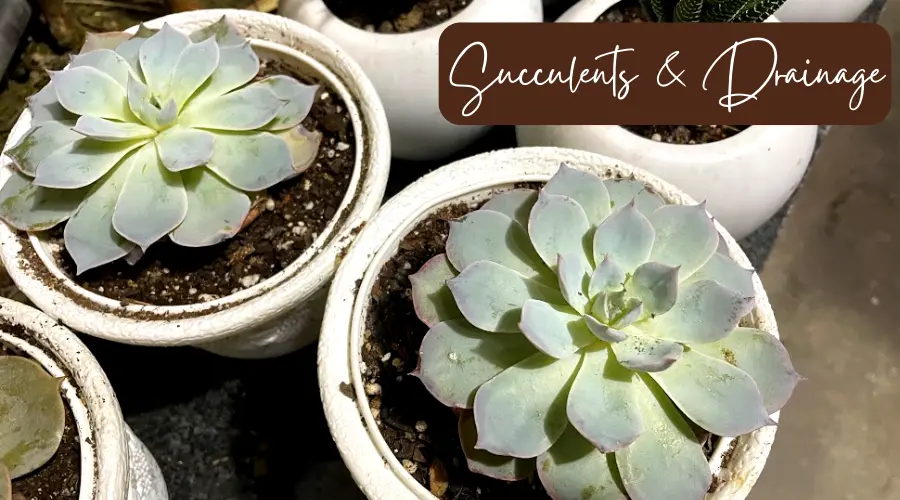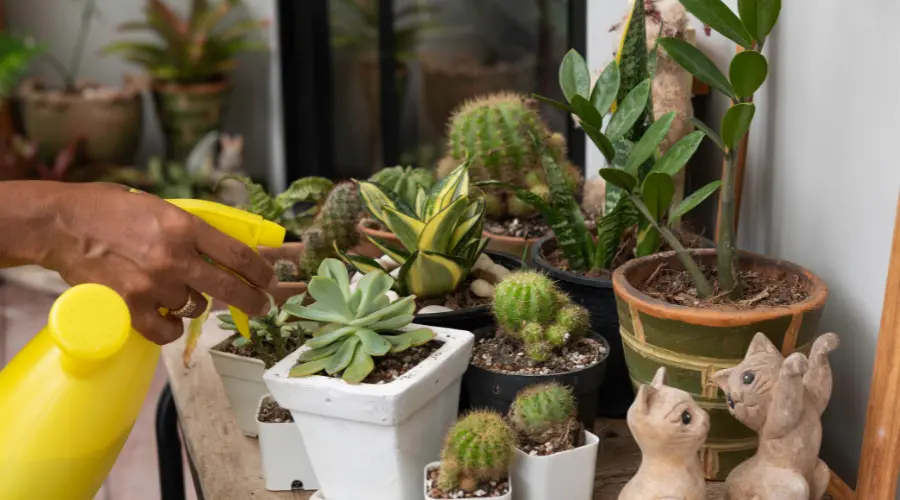If you’re a succulent lover, then you know that drainage is key to keeping your plants healthy. But what do you do if you don’t have good drainage in your succulent pot?
Here are 6 things you need to know to get your succulents the drainage they need!

Let’s get started!
Do Succulents Need Drainage?
Succulents need drainage. Any standing water may easily escape the container with proper drainage, keeping the soil dry. It mainly affects succulents since their tissues, leaves, and stems can store large amounts of water. They rot if their roots are submerged in water for too long.
For some, it is an absolute must that all planters include drainage holes. For, other gardeners it’s not mandatory.
The most common issue that individuals have is related to irrigation. The common practice of overwatering succulents may kill them. Succulents may thrive in containers without drainage if you properly hydrate them.
Do Succulents Need Drainage Holes?
Succulents prefer containers with drainage holes. However, this is not a must for successful cultivation. Without drainage holes, succulents may still live and even flourish. It’s up to you how well the plants are taken care of.
It is advised that succulents and cacti be grown in containers with drainage holes. However, this is not a must for success.
It merely means you’ll have to be extra cautious about watering your succulents and keeping an eye on the humidity levels in the soil.
Remember that succulents may survive in dry conditions because of the water they store in their fleshy leaves and sturdy stems.
They may now go longer without needing to be watered. Allowing succulents to remain in damp soil can cause the roots to rot since the plants cannot absorb the extra water.
Why do Succulents Need Drainage?
Drainage is crucial for succulents since it helps to avoid root rot and mortality. Succulents in containers lacking drainage holes need less water and less frequent watering.
The easiest way to care for a succulent is to plant it in a container with drainage holes and use a potting mix that drains properly.
To improve drainage in a container without drain holes, try using sand instead of soil or a layer of gravel at the bottom of the container.
Can you put a Succulent in a Pot without Holes?
Growing succulents in a container without drainage holes are doable. To collect water at the bottom of your container, place a layer of rocks, pebbles, or pumice stone at your pot’s bottom.
Root rot, fungus, and parasites may be prevented by adding an extra layer or two of material between the soil and the bottom of the pot.
A half-inch charcoal coating is recommended over the rocks before covering them with dirt.
If a succulent is small, you may want to put it in a shallow pot that isn’t too deep or in another creative container. Remember that succulents thrive in arid conditions and may even die from too much water.
Succulents in containers without drainage holes may benefit from a little spray now and then rather than daily irrigation.
It is crucial to monitor your succulent plant to avoid overwatering since succulents like to have their soil completely dry out between waterings.
To be safe, the soil must be damp to the surface. Succulents grown outside or in a greenhouse need weekly watering throughout the summer.
A succulent requires heavy watering once each month throughout the winter.
Succulents can survive for extended periods without water, so you should only need to water them once every two weeks.
To prevent your succulent from dying from receiving too much water, misting is recommended. Succulents need just little watering—once or twice per month is ideal.
The soil should be slightly wet, and the leaves should have beads of water that drop off once or twice a month. A good rule of thumb is to put your finger in the soil and stop when it’s damp.
How often should I water my succulents without drainage?
If your Succulents are in a pot without drainage, they can be watered once every week or once per two weeks. You need to check the soil and water it only when the top soil is dry.
If you water more, it can be trapped inside the pot and as it cannot drain it may cause root rot to your succulent plants. Also, when watering don’t put too much water at once. Only add a small amount of water at a time.
How do you water succulents without drainage?
The success of your plants in containers with no drainage holes will depend on how well you water them. Don’t overwater since it won’t drain out of the container.
If you tend to overwater your plants, you should take caution while watering containers without drainage holes. Leave the soil to dry out somewhat between waterings.
1. Utilize a Needle or Spray Bottle
For more precise water measurement, a syringe, spray bottle, or squeeze bottle might be helpful. It’s important to remember to spray the soil, not the plant itself while using a spray bottle.

The water needs to reach the plant’s roots so that it may be absorbed.
2. Reduce Water Levels
You may dump the extra water by tipping the pot over while holding down the plants to prevent them from falling out if you overwater them. Another option is to use a dry towel or paper to absorb the surplus moisture.
3. If it starts to rain, you Would better move the pot
If you keep your plants outside and their containers don’t have drainage holes, bring them inside or somewhere shady when rain is in the forecast.
If it rains on the pots and you neglect to move them, empty the water as quickly as possible.
Your plants will begin to fade if they don’t get enough water. The leaves are frequently the first to go. If your plant seems flimsy when you touch it, it’s probably because you’re watering it too little.
Final Words
Let’s conclude the post on whether Succulents Need Drainage for them to thrive and grow well!
Succulents are a great plant for people who want to enjoy the beauty of nature without having to put in too much work. They are easy to care for and can thrive in a variety of conditions.
However, it is important to remember that succulents need drainage to stay healthy.
I hope you understood how you can work on watering them now. If you are watering more or too often do change that and only water as much as required.
I hope you enjoyed reading the post.
